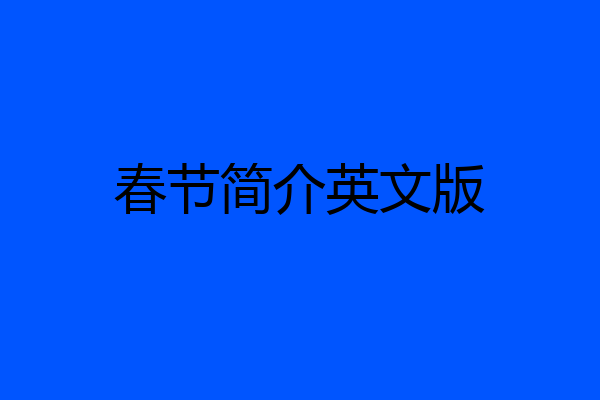
正版TJ状妈
写作思路:以介绍春节的来源作为开头,之后介绍春节的习俗,和各地之间不同的气氛特点,最后描述之所以会是重要节日的原因,正文:
The Spring Festival, the Lunar New Year, is the first year of the year and also the traditional "New Year's Day".
春节,即农历新年,是一年之岁首,亦为传统意义上的“年节”。
Spring Festival has a long history, which evolved from the first year of prayer in ancient times.
春节历史悠久,由上古时代岁首祈年祭祀演变而来。
During the Spring Festival, various activities are held throughout the country to celebrate the Spring Festival, with a lively and festive atmosphere.
在春节期间,全国各地均有举行各种庆贺新春活动,热闹喜庆的气氛洋溢。
There is a legend about the origin of the Spring Festival.
春节的来历有一种传说。
In ancient China, there was a monster called Nian, with long antennae and unusual ferocity.
中国古时候有一种叫“年”的怪兽,头长触角,凶猛异常。
Nian lived deep in the sea for many years.
“年”长年深居海底。
He did not climb ashore until New Year's Eve, devouring livestock and hurting people's lives.
每到除夕才爬上岸,吞食牲畜伤害人命。
Therefore, on New Year's Eve, people take the old and the young to escape to the mountains to avoid the harm of the Nian.
因此,每到除夕这天,村村寨寨的人们扶老携幼逃往深山,以躲避“年”兽的伤害。
Later on New Year's Eve, an old beggar from outside the village told people how to drive out the Nian.
后来有一年除夕,从村外来了个乞讨的老人,告知了人们驱赶“年”兽的办法。
Originally, Nian was most afraid of red, fire and explosion.
原来,“年”最怕红色、火光和炸响。
Since then, every New Year's Eve, families stick red couplets and set off firecrackers.
从此每年除夕,家家贴红对联、燃放爆竹。
Households have bright candles and wait for the new year.
户户烛火通明、守更待岁。
In the early morning of the Eleventh day, we have to go to relatives and friends to say hello.
初一一大早,还要走亲串友道喜问好。
This custom has become the most solemn traditional festival among Chinese people.
这风俗越传越广,成了中国民间最隆重的传统节日。


背信弃翊
春节英文介绍可先总述春节的性质,再描述春节的定义,最后描述春节的传统习俗。
范文:
The Spring Festival is the most important festival for the Chinese people and is when all family members get together, just like Christmas in the West.
春节是中国人民最重要的节日,所有家庭成员聚在一起,在西方圣诞节一样。
All people living away from home go back, becoming the busiest time for transportation systems of about half a month from the Spring Festival. Airports, railway stations and long-distance bus stations are crowded with home returnees.
所有远离家乡的人都要回家,成为了为期半个月左右的运输系统最繁忙的时间——春运。机场,火车站和长途巴士站都挤满了回家的人。
Strictly speaking, the Spring Festival starts every year in the early days of the 12th lunar month and will last till the mid-1st lunar month of the next year.
严格地说,春节是指从腊月初开始一直到第二年中旬的一个月。
Of them, the most important days are Spring Festival Eve and the first three days. The Chinese government now stipulates people have seven days off for the Chinese Lunar New Year.
其中,最重要的日子是除夕和一年的前三天。现在中国政府规定,人民在中国农历新年有七天的休假。
Many customs accompany the Spring Festival. Some are still followed today, but others have weakened.
春节的时候有不少传统习俗。有的人至今还在保持,不过有的人已经慢慢淡化了这种习俗。
At this time, people offer sacrifice to the kitchen god. Now however, most families make delicious food to enjoy themselves.
在这个时候,人们祭祀灶神。但是现在,大多数家庭做出美味的食物来过节

小苹果花苑
每一个节日都有它存在的意义,那么你知道这些节日有哪些知识点呢?下面,我在这给大家带来春节的英文版介绍,欢迎大家借鉴参考!
Chinese Spring Festival, also called Lunar New Year, has more than 4,000 years of history. Being one of the traditional Chinese festivals, it is the grandest and the most important festival for Chinese people. It is also the time for the whole families to get together, which is similar with Christmas Day to the westerners.
中国的春节,也被称为农历新年,迄今已有四千多年的历史。对于中国人来说,这是规模最大,最重要的传统节日。就如同西方的圣诞节一样,春节是一家团聚的日子。
Originating during the Shang Dynasty (about 17th - 11th century BC), Spring Festival, which celebrates family reunion, is full of rich and colorful activities, and hopes with the advent of spring and flowers blossoming. People from different regions and different ethnic groups celebrate it in their unique ways.
春节起源于商朝(公元前11-17世纪),为了庆祝全家团圆和表达对春暖花开的期盼,节日期间会准备丰富多彩的活动。不同地区和不同少数民族人们会用自己独特的方式庆祝这一传统节日。
Legends
春节传说
There are many legends about Spring Festival in Chinese culture. In folk culture, it is also called “guonian” (meaning “passing a year”). It is said that the “nian” (year) was a strong monster which was fierce and cruel and ate one kind of animal including human being a day. Human beings were scared about it and had to hide on the evening when the “nian” came out. Later, people found that “nian” was very scared about the red color and fireworks. So after that, people use red color and fireworks or firecrackers to drive away “nian”. As a result, the custom of using red color and setting off fireworks remains.
中国文化中有很多关于春节的传说。在传统文化中,春节亦被称为“过年”。传说“年”是一种凶猛异常的怪物,每天都会吃一种动物(包括人)。人们非常惧怕他,当“年”夜间出来活动时,人们会找地方躲起来。后来,人们发现“年”非常害怕红色和爆竹,于是,人们用红色和鞭炮来驱赶“年”。久而久之,春节用大红色和放鞭炮的习俗就保留了下来。
Festivities Schedule
春节活动
Preparing the New Year starts 7 days before the New Year’s Eve. According to Chinese lunar calendar, people start to clean the house on Dec. 24, butcher on Dec. 26th and so on. People have certain things to do on each day. These activities will end Jan. 15th of the lunar calendar.
新年的准备工作在除夕前的七天就开始了。根据中国农历,人们从腊月二十四开始打扫屋子,二十六日杀猪宰羊等等。每一天都有不同的活动,所有这些活动将在正月十五结束。
Taboos
春节禁忌
The Spring Festival is a start for a new year, so it is regarded as the omen of a year. People have many taboos during this period. Many bad words related to “death”, “broken”, “killing”, “ghost” and “illness” or “sickness” are forbidden during conversations. In some places, there are more specific details. They consider it unlucky if the barrel of rice is empty, because they think they will have nothing to eat in the next year. Taking medicine is forbidden on this day, otherwise, people will have sick for the whole year and take medicine constantly.
春节是新的一年的开始,预示着一年的运气,所以过年期间有很多禁忌,比如“死”“破”“杀”“鬼”“病”这类字眼是谈话中要避免的。在某些地方还有一些特殊的禁忌,比如新年米缸空了不是好兆头,因为这预示着新的一年将没东西吃,春节那天也不能吃药,这会预示着新的一年疾病产生,医药不断。
优质英语培训问答知识库